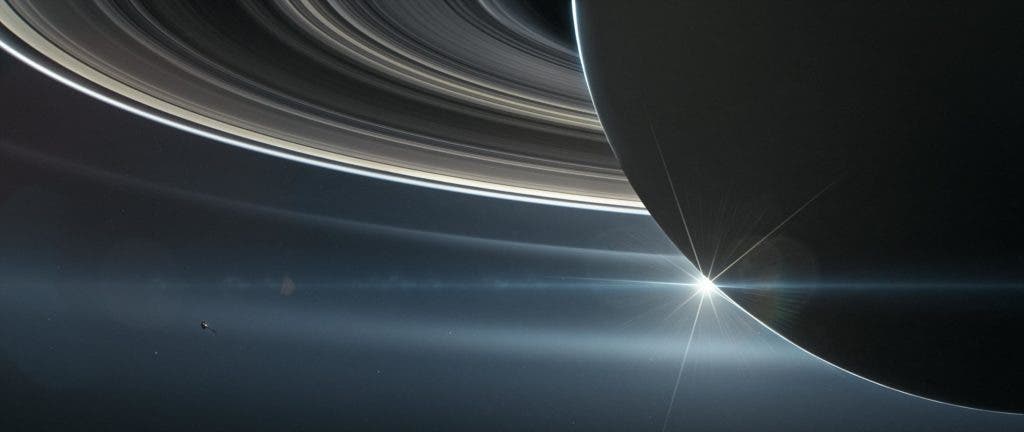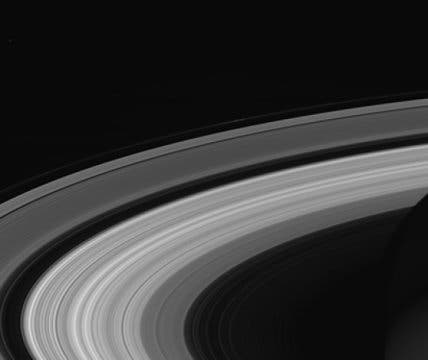Saturn’s days are 10 hours, 33 minutes, and 38 seconds long — and we know this by looking at wave patterns in its rings.

Illustration showing NASA’s Cassini spacecraft in orbit around Saturn.
Image credits NASA / JPL-Caltech.
New observations from NASA’s Cassini spacecraft allowed researchers at the University of California Santa Cruz to calculate Saturn’s rate of rotation. This measurement — the most precise determination of its rotation rate — was based on observations of wave patterns created within the planet’s rings.
Timekeeping rings
“Particles in the rings feel this oscillation in the gravitational field. At places where this oscillation resonates with ring orbits, energy builds up and gets carried away as a wave,” explained Christopher Mankovich, a graduate student in astronomy and astrophysics at UC Santa Cruz, and lead author of the study.
Just like our own planet, Saturn vibrates in response to perturbations (large-scale movement of matter). Unlike our planet, these perturbations come not from the movement of tectonic plates, but likely from heat-driven convection in the planet’s gassy bulk. Such internal oscillations move about massive quantities of gas, which has a noticeable impact on local densities within Saturn’s atmosphere. Such changes, in turn, cause noticeable changes in the planet’s localized gravitational pull. And, even better, the frequency of oscillation within Saturn carries over to the gravitational effects — in short, they share the same ‘fingerprint’, so these internal events can be linked to their external, gravitational effects.

Image of Saturn’s rings taken by NASA’s Cassini spacecraft on Sept. 13, 2017.
Image credits NASA / JPL-Caltech / Space Science Institute.
Naturally, we’d need satellites or other sorts of equipment in orbit across the planet to pick up on such gravitational fluctuations. Which we haven’t really brought over yet. Rather conveniently, however, Saturn has a sprawling ring system surrounding it. They do react to the planet’s gravitational pull, its fluctuations causing certain wave patterns to form inside the rings. Not all patterns seen inside the rings are caused by gravitational effects — but most are.
In effect, this makes the rings act similarly to seismographs, devices that we use to measure earthquakes.
“Some of the features in the rings are due to the oscillations of the planet itself, and we can use those to understand the planet’s internal oscillations and internal structure,” says Jonathan Fortney, professor of astronomy and astrophysics at UC Santa Cruz and paper coauthor.
NASA’s Cassini spacecraft allowed researchers to observe Saturn’s rings in unprecedented detail. Mankovich’s team developed a series of models of the planet’s internal structure and used them to predict the frequency spectrum of Saturn’s internal vibrations. Then they compared their predictions to waves observed by Cassini in Saturn’s C ring.
One of the main results of this study is an estimation of Saturn’s speed of rotation — which has been notoriously difficult to accurately pin down. Saturn is basically a huge clump of gas and, as such, its surface doesn’t have any fixed, distinctive features we could track as it rotates. The planet is also unusual in that its magnetic poles are nearly perfectly aligned to its axis of rotation — so we can’t track those either. On Earth, for example, the magnetic poles aren’t aligned with this axis.
Mankovich’s team determined that a day on Saturn lasts for 10 hours, 33 minutes, and 38 seconds — several minutes shorter than previous estimates (which were based on radiometry readings from the Voyager and Cassini spacecraft).
“We now have the length of Saturn’s day, when we thought we wouldn’t be able to find it,” said Cassini Project Scientist Linda Spilker.
“They used the rings to peer into Saturn’s interior, and out popped this long-sought, fundamental quality of the planet. And it’s a really solid result. The rings held the answer.”
The paper “Measurement and implications of Saturn’s gravity field and ring mass” has been published in the journal Science.









